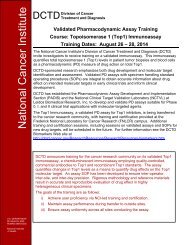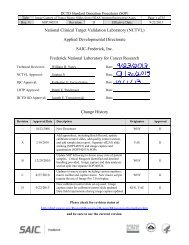National Cancer Institute - NCI Division of Cancer Treatment and ...
National Cancer Institute - NCI Division of Cancer Treatment and ...
National Cancer Institute - NCI Division of Cancer Treatment and ...
Create successful ePaper yourself
Turn your PDF publications into a flip-book with our unique Google optimized e-Paper software.
Several BRB statisticians demonstrated<br />
that naïve application <strong>of</strong> st<strong>and</strong>ard statistical<br />
inference procedures to these measures<br />
<strong>of</strong> association can result in greatly<br />
inflated testing type I error rates <strong>and</strong><br />
confidence intervals with poor coverage<br />
probabilities. These results suggest that<br />
some <strong>of</strong> the claims <strong>of</strong> exceptional prognostic<br />
classifier performance that have<br />
been reported in prominent biomedical<br />
journals in the past few years should be<br />
interpreted with great caution.<br />
Lusa L, McShane LM, Radmacher MD, Shih JH,<br />
Wright GW, Simon R. Appropriateness <strong>of</strong> some<br />
resampling-based inference procedures for<br />
assessing performance <strong>of</strong> prognostic classifiers<br />
derived from microarray data. Revision under<br />
review with Stat Med.<br />
Drs. Zhao, Li, <strong>and</strong> Simon developed a mixture<br />
model-based normalization method<br />
that adaptively identifies non-differentially<br />
expressed genes <strong>and</strong> thereby substantially<br />
improves normalization for dual-labeled<br />
arrays in settings where the assumptions<br />
<strong>of</strong> global normalization are problematic.<br />
Zhao Y, Li MC, Simon R. An adaptive method for<br />
cDNA microarray normalization. BMC Bioinformatics<br />
2005:6;28.<br />
Clinical Trial Designs for the<br />
Development <strong>of</strong> Cytostatic Drugs<br />
Many new anticancer agents being developed<br />
are not cytotoxic <strong>and</strong>, therefore, may<br />
not cause tumors to shrink appreciably.<br />
However, these agents may still <strong>of</strong>fer<br />
significant clinical benefit to patients<br />
by delaying the progression <strong>of</strong> disease.<br />
Because st<strong>and</strong>ard phase I/II/III clinical trial<br />
development <strong>of</strong> agents depends on their<br />
ability to show activity in phase II trials<br />
by tumor shrinkage, new approaches are<br />
■ ■ ■<br />
Naïve application <strong>of</strong> st<strong>and</strong>ard statistical<br />
inference procedures can result in errors.<br />
needed. BRB statisticians Drs. Hunsberger,<br />
Korn, <strong>and</strong> Rubinstein discuss <strong>and</strong> evaluate<br />
several new design approaches.<br />
Korn EL, Rubinstein LV, Hunsberger SA, Pluda JM,<br />
Eisenhauer E, Arbuck SG. Clinical trial design for<br />
cytostatic agents <strong>and</strong> agents directed at novel<br />
molecular targets. In: Strategies for Discovery <strong>and</strong><br />
Clinical Testing <strong>of</strong> Novel Anticancer Agents. Adjei<br />
AA, Buolamwini J, eds. New York: Elsevier; 2005.<br />
Hunsberger S, Rubinstein LV, Dancey J, Korn EL<br />
Dose escalation trial designs based on a molecularly<br />
targeted endpoint. Stat Med 2005:24;<br />
2171–81.<br />
Drs. Freidlin <strong>and</strong> Simon evaluated two<br />
kinds <strong>of</strong> r<strong>and</strong>omized designs for the early<br />
development <strong>of</strong> target-based cytostatic<br />
agents: r<strong>and</strong>omized discontinuation <strong>and</strong><br />
upfront r<strong>and</strong>omization designs. They<br />
showed that the r<strong>and</strong>omized discon-<br />
tinuation design is not as efficient as<br />
upfront r<strong>and</strong>omization if treatment<br />
has a fixed effect on tumor growth<br />
rate or if treatment benefit is<br />
restricted to slower-growing<br />
tumors. The r<strong>and</strong>omized<br />
discontinuation design<br />
can be advantageous if only<br />
a subset <strong>of</strong> patients, those<br />
expressing the molecular<br />
B I O M E T R I C R E S E A R C H B R A N C H ■ 21










